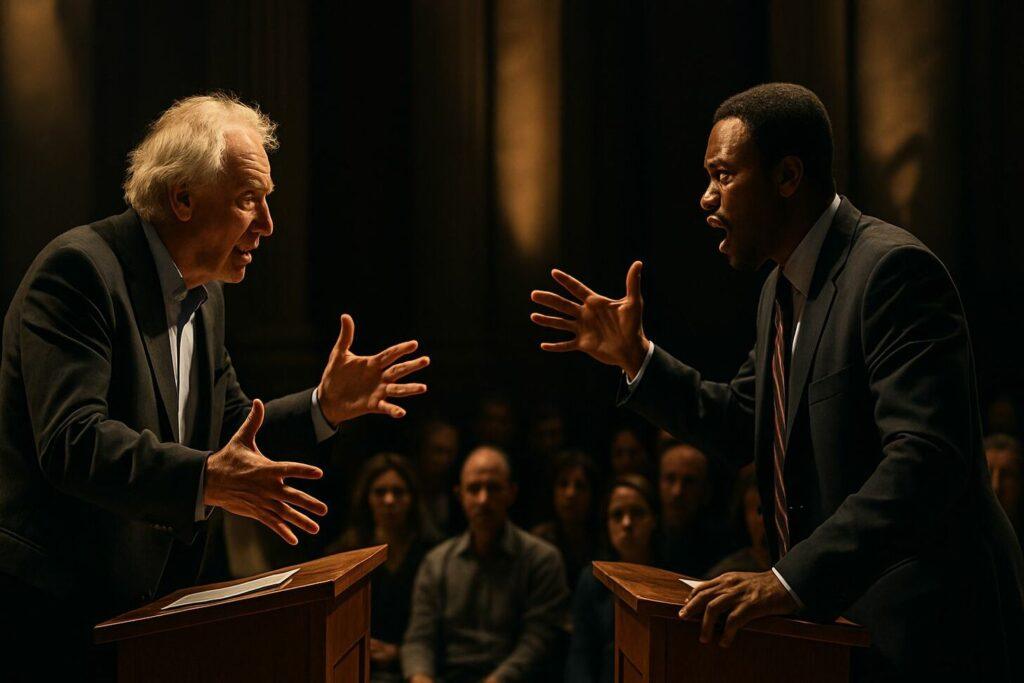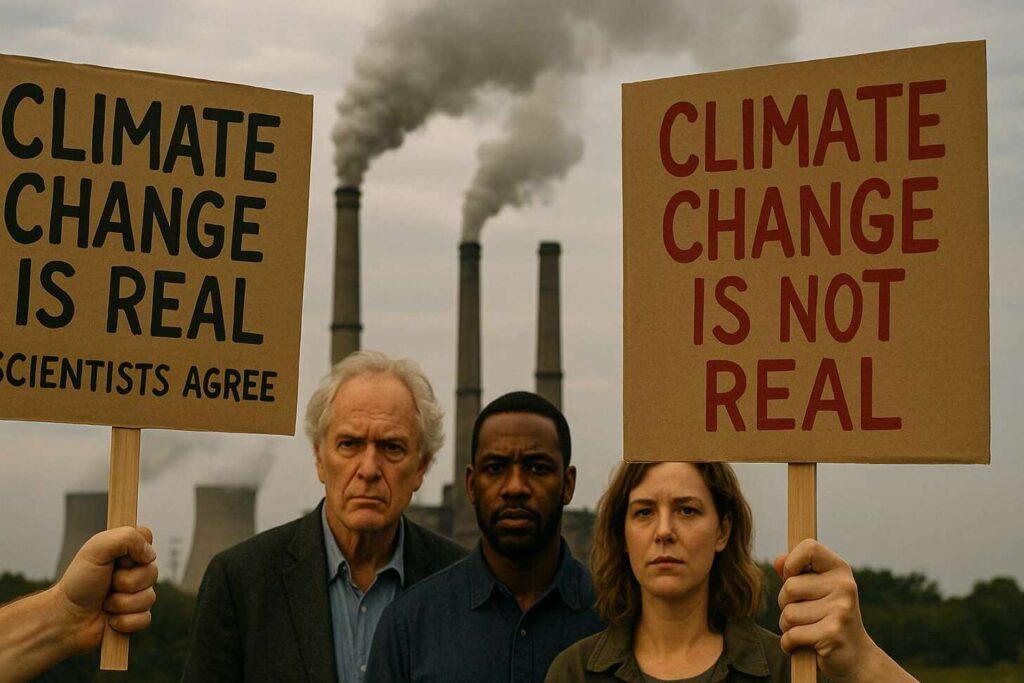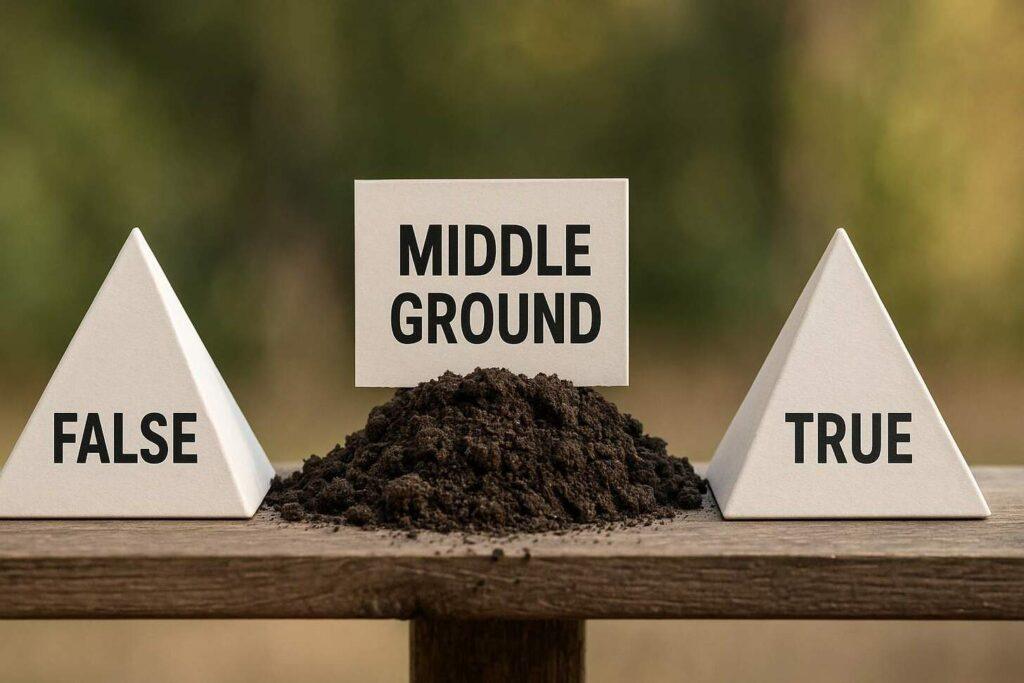Have you ever assumed the “middle answer” must be right? This instinct to split differences drives the middle ground fallacy mental model—a thinking trap where people believe truth always lies between two opposing views, even when one side lacks evidence. Let’s explore why this happens and how it shapes decisions.
Take climate change debates. Scientists overwhelmingly agree human activity fuels global warming. Yet some treat climate denial as a valid “other side,” suggesting reality must be halfway.
Similarly, vaccine safety discussions often downplay 99% consensus to accommodate unfounded doubts. These compromises ignore facts for false balance.
Why does this matter? Misguided neutrality can stall progress. Imagine dismissing fire alarms because “maybe it’s just a drill.” This guide will show how to spot the fallacy, avoid its pitfalls, and make choices rooted in evidence—not just compromise.
Key Takeaways
- The middle ground fallacy mental model assumes truth exists between extremes, even without proof.
- It often undermines scientific consensus, like in climate or vaccine debates.
- False compromises can mislead decision-making and delay solutions.
- Recognizing this pattern helps you prioritize evidence over forced balance.
- This article provides tools to identify and counter this mental shortcut.
The Middle Ground Fallacy Mental Model Explained
When two people argue, does the truth automatically sit halfway? Not always. This thinking error happens when we treat opposing ideas as equally valid—even if one lacks proof. Let’s unpack how this works and why it matters.
How the Trap Springs Shut
Picture a debate: Side A claims “100% yes,” Side Z says “100% no.” The fallacy kicks in when we assume answer M (50/50) must be right. But what if Side A has mountains of data?
Choosing M ignores facts just to split the difference on this topic, which has been discussed for years. This example illustrates the nature of false compromises.
When “Balance” Tips the Scales
News outlets sometimes fall into this pattern. Imagine a story on Earth’s shape: giving equal airtime to flat-Earthers and scientists creates false equivalence. The argument feels fair, but distorts reality. Have you seen this in politics or health discussions?
Policy debates often suffer too. If one group wants $10 million for schools and another wants $0, meeting at $5 million might seem reasonable. But does that number actually solve the problem? Blind compromise can waste resources or prolong issues.
Next time you hear clashing views, ask: Is there real evidence for both sides? Or are we just picking M because it feels safer? Recognizing this pattern helps us make smarter choices—not just convenient ones.
Middle Ground Fallacy Mental Model’s Roots

Why do we instinctively seek compromise? This fallacy in reasoning traces back centuries. Ancient debates about truth often split into two camps: those demanding proof and others trusting intuition.
Over time, this tension shaped how people weigh conflicting ideas, forming a complex landscape of thought.
Historical Context: Middle Ground Fallacy Mental Model
In medieval Europe, scholars argued whether knowledge came from divine revelation or human reason. Some tried blending both—a position that sometimes ignored evidence. For example, 16th-century astronomers faced pressure to “split the difference” between Earth-centered and Sun-centered solar system models, delaying scientific progress.
Early democratic societies faced similar challenges. Founding fathers debated how much power to give central governments versus states. The Constitution became a living document because rigid compromise couldn’t solve every problem. Does history show extremes occasionally hold more truth than negotiated settlements?
Key Philosophical Influences
Philosopher Michael Polanyi highlighted two forms of knowledge: explicit (facts) and tacit (experience). His work explains why some people prioritize feelings over data during disagreements. Think of vaccine debates: personal stories often clash with statistical safety rates.
This divide remains part of modern life. From workplace disputes to family dinners, we balance facts with relationships. The key? Recognize when evidence clearly favors one side—even if it feels uncomfortable. How often do you default to “meeting halfway” without checking the facts first?
Compromise May Not Always Be Rational

Does finding common ground guarantee the right answer? Consider fire safety rules. If one group demands smoke detectors in every room and another opposes all alarms, would “one detector per floor” make sense? This false balance ignores the reality of how fires spread.
Take seatbelt debates. Scientists proved decades ago they save lives. Yet some still argue for “optional use” as a middle path. Splitting the difference here risks lives to appease opinions—not facts. When evidence strongly supports one side, forced compromises become dangerous.
Public policy often faces this trap. Imagine two proposals: $10/hour minimum wage vs. $0. Meeting at $5 might feel fair, but does it actually help workers? Numbers should follow data, not just ease tension. Sometimes the extreme position holds the complete truth.
Why do we default to halfway solutions? It feels safer than picking sides. But when 97% of climate scientists agree on human-driven change, dismissing their consensus for “balance” delays action. Next time you hear opposing views, ask: Is there equal proof for both positions? Or are we sacrificing reason for peacekeeping?
Middle Ground Fallacy Affects Decisions

When debates heat up, do we truly weigh the facts—or just split the difference? This thinking pattern shapes crucial topics like climate policy and public health. Let’s explore how false compromises muddy the waters.
Effects on Policy and Public Opinion
Taking a middle position often pleases crowds but ignores data. Climate discussions show this clearly: 97% of scientists agree humans drive global warming. Yet media often pairs experts with skeptics, making viewers think “the truth is somewhere in between.” Does this help anyone?
| Issue | Compromise Position | Evidence-Based Answer |
|---|---|---|
| Climate Change | “Both sides have points” | Immediate emission cuts needed |
| Vaccine Safety | “Delay mandates for now” | Follow 99% consensus on effectiveness |
| Media Coverage | “Equal time for all views” | Prioritize peer-reviewed research |
Splitting the half works for pizza slices—not policy. Imagine setting speed limits by averaging racers’ and pedestrians’ preferences. Sounds silly? Yet we do this with serious issues. Without enough evidence, compromises become guesses dressed as solutions.
What happens next? Confusion grows. People think complex answers don’t exist. But real change requires courage to stand on facts—not just shake hands in the middle. Next time you hear “meet halfway,” ask: Does the data back this ground, or are we avoiding tough choices?
Case Study: Climate Change and the Fallacy

Climate change is real—scientists agree human actions drive it. Over 95% of recent warming comes from fossil fuels and deforestation. Yet public opinion often splits. Why? Media sometimes treats climate science like a debate with two equal sides.
Scientific Consensus vs. Public Opinion
Researchers have mountains of data showing carbon emissions heat our planet. Satellites track melting ice. Thermometers break records yearly. But polls show 30% of Americans doubt human impact. How? When news outlets give climate deniers equal airtime, it creates false balance. Imagine weather reports saying “50% chance of rain” while storms flood streets.
Media Influence on Perception
Some networks frame climate talks as “economy vs. environment.” This money-focused form ignores solutions like green jobs. Fossil fuel groups fund misleading ads, making gradual changes seem radical. For example, one study found 80% of climate articles mention “uncertainty” but only 20% explain the overwhelming proof.
Should truth bend to opinions? When 10 doctors say “smoking kills” and 1 disagrees, we don’t split the difference. Climate science deserves the same sense of urgency. Next time you hear “both sides,” ask: Does evidence back both—or is this a dangerous compromise?
Vaccines and The Middle Ground Fallacy Model

What happens when 99% agree but we act like they don’t? Vaccine debates show how seeking compromise can backfire. Decades of research prove vaccines save lives, yet many people still treat safety concerns as a two-sided argument. This creates false uncertainty where little exists.
Imagine a school board meeting. Ten doctors explain measles shots work. One parent shares a fear-based story. Splitting the difference—like delaying mandates—feels fair. But does it make sense? Studies show hesitation often grows when we treat disproven ideas as valid. The negative consequences are real: measles cases tripled in 2019 after some communities adopted “middle” policies.
Why does this matter? When science has a clear answer, compromise risks lives. If 100 pilots agree a plane is safe, would you still demand “balance” from one skeptic? Vaccine debates face the same trap. Misinformation spreads when we give equal weight to weak evidence.
Is splitting the difference wise here? No—it’s like adding seatbelts to half the cars. Next time you hear vaccine talks, ask: Does the evidence support both sides? Or are we creating doubt where none belongs? Trust data, not diluted answers, to protect public health.
Evidence vs. False Equivalence

Not all debates deserve equal footing. Imagine someone claims garlic cures infections as well as antibiotics. Without proof, this false equivalence misleads people. Solid evidence acts like a truth filter—separating facts from hunches.
Take health scams. A company says their juice “balances energy” like prescription drugs. They appeal ignorance by suggesting both options work. But real science demands data—not just feel-good ideas. Would you trust a parachute that “might” open?
| Issue | False Compromise | Evidence-Based Approach |
|---|---|---|
| Health Claims | “Both natural and medical solutions work” | Require clinical trial results |
| Policy Making | “Split funding between proven/unproven programs” | Allocate based on success metrics |
| Product Safety | “Let consumers choose risky items” | Ban products failing safety tests |
Why does form matter? A school project shows this. If one kid wants to build with popsicle sticks and another with steel rods, compromise isn’t about mixing materials—it’s about load-bearing facts. Check the substance before accepting any middle answer.
Next time you hear conflicting views, ask: “Where’s the proof?” If one side shows peer-reviewed studies and the other shares rumors, that’s not balance—it’s noise. Trust evidence, not handshakes in the middle. After all, would you let someone sell you a car without proving it runs?
Middle Ground Fallacy Model Myths and Errors

Does admitting “I don’t know” mean the answer lies halfway? Many confuse uncertainty with accuracy, treating gaps in knowledge as proof that compromise positions hold truth. This pattern fuels poor choices—like choosing lukewarm solutions when clear answers exist.
Mistaking Uncertainty for Accuracy
Imagine two friends arguing about a movie’s runtime. One says 90 minutes, another claims 150. Instead of checking, you guess 120. This “split the difference” habit ignores the concept of verification. Real-world debates often follow this flawed thinking.
| Situation | Misconception | Reality |
|---|---|---|
| Historical Disputes | “Ancient texts are unclear, so truth must be in between” | Archaeological evidence often confirms one version |
| Everyday Decisions | “I’m unsure, so 50/50 is safest” | Research or expert input provides clarity |
| Scientific Topics | “No full consensus = both sides valid” | Majority agreement usually reflects strong proof |
Consider jury trials. If 11 jurors vote guilty and 1 disagrees, does “maybe guilty” make sense? Courts demand certainty—not watered-down verdicts. Similarly, logical errors thrive when we treat “half” answers as wise.
Why do we default to this question? Uncertainty feels uncomfortable. But saying “I need more data” beats pretending vagueness equals truth. Next time you face conflicting views, ask: Is there actual evidence for a middle path—or just fear of picking sides?
Logic vs. False Middle Ground Model Fallacies

How do you spot the difference between solid reasoning and fake balance? A logical argument builds on facts like bricks in a wall. False compromises? They’re sandcastles—look complete until the tide hits.
Take workplace budget talks. Team A wants $50K for safety upgrades backed by injury reports. Team B demands $0, claiming “costs too much.” A “split the difference” $25K solution ignores evidence. Does it fix the problem? No—it just feels fair.
Here’s how to tell them apart:
- Evidence check: Real arguments cite studies, stats, or expert quotes. False ones say “both sides deserve respect” without proof.
- Money matters: Watch for claims like “expensive solutions aren’t worth it.” Valid points show cost-benefit analysis, not just price tags.
- Step-by-step test: Ask: 1) What’s the core issue? 2) What proof supports each side? 3) Does the compromise address reality?
Consider health debates. One group cites 20 studies linking soda to diabetes. Opponents argue “personal choice.” Meeting halfway with “smaller cups” misses the point—like putting bandaids on broken bones.
When misleading arguments dress as compromises, ask: “What gets ignored?” If everything else—like safety data or long-term costs—gets sidelined, you’ve found a fake balance. True solutions stand on evidence, not handshakes.
Next time you hear “let’s meet in the middle,” dig deeper. Does the conclusion hold water? Or is it just muddying the facts? Trust proof, not polite halfway houses.
The Middle Ground Fallacy Between The Extremes

Ever faced a choice between two bad options? Real life rarely fits neat “either/or” boxes. Ideas live on sliding scales—not just at the ends. Let’s unpack how to navigate this gray area without falling for fake balance.
Take bedtime rules. One side pushes for 10 PM curfews, others resist any limits. The truth? Teens need 8-10 hours of sleep. A 1 AM bedtime ignores biology, but strict rules without flexibility spark rebellion. Real-world change happens when we adjust based on evidence, not just split differences.
History shows forced middles often fail. Remember King Solomon’s famous judgment? Two women claimed the same baby. His “split the child” threat revealed the real mother—she refused the compromise. The core argument wasn’t about sharing but identifying truth.
| Situation | Valid Compromise | Forced Middle |
|---|---|---|
| Screen Time Rules | 2 hours on school nights + flexibility weekends | “1 hour daily” ignoring homework needs |
| Diet Debates | 80% whole foods + 20% treats | “Eat half salad, half candy daily” |
| Health Claims | Combine exercise with proven supplements | “Use half medicine, half magic crystals” |
Modern debates repeat this pattern. Take work hours: 19th-century laborers fought for 8-hour days—a middle between 16-hour shifts and no work. This idea stuck because it balanced health and productivity. But when one side offers data and others resist facts, meeting halfway breeds half-baked solutions.
Is the moderate view always best? Not if it ignores proof. Imagine arguing whether water is wet. If 100 scientists say “yes” and 1 says “no,” splitting the difference teaches doubt. Next time you face extremes, ask: Does the truth lean clearly one way? Or are both sides missing key pieces?
Spotting and Avoiding The Fallacy

Everyday choices often hide hidden traps. How do you spot when a compromise lacks proof? Start by treating evidence like a flashlight—it reveals what’s real versus imagined. Let’s explore simple ways to cut through foggy thinking.
Follow the Numbers
Imagine planning a family budget. One person wants $500/month for dining out, another insists on $0. Does $250 solve anything? Check bank statements first. If last year’s average was $600, the “middle” ignores reality. Data cuts through opinions like scissors through paper.
Ask Three Questions
Next time someone suggests splitting the difference, ask:
- What proof supports each side?
- Does the compromise address the core problem?
- Are we ignoring experts to keep peace?
Take vaccine debates. If 99% of studies confirm safety, why discuss “both sides”? Practice saying: “Show me the research.” This approach works for work disputes, parenting choices, even car repairs.
Want to learn faster? Track your decisions for a week. Note when you default to halfway answers without checking facts. Like training wheels, this habit builds critical thinking muscles. Soon, you’ll spot weak compromises like a chef smells burnt toast.
Remember: True solutions stand on substance, not handshakes. What evidence supports your last compromise? Could digging deeper reveal a better path?
Conclusion
When does seeking harmony cloud our judgment? This thinking pattern—born from ancient debates and modern pressures—often distorts reality. We’ve seen how treating climate science and vaccine safety as two-sided debates fuels confusion. The negative consequences ripple through policy and public health.
What matters most? Letting evidence lead—not compromise. Whether facing school board decisions or workplace conflicts, ask: “Does this solution address facts or just feelings?” Tools like data checks and expert input cut through false balance.
Remember the truth about climate change? 97% agreement isn’t a debate—it’s a call to act. Next time you hear opposing views, pause. Are both sides equally proven? Or are we dodging tough choices for temporary peace?
Your move: Revisit recent arguments. Did you default to halfway answers without proof? Progress lives in clarity, not comfortable middles. Ready to choose truth over easy answers?


